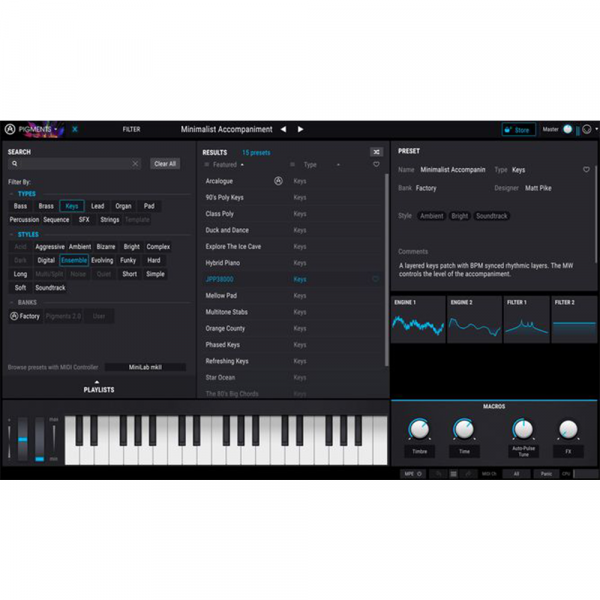

It’s a brilliant GUI that allows you to see almost the entire patch in real time, thus making it much easier to edit and construct a sound. The sound engine has a real time graphic display of the wavetable, while the filters have real time displays of the filter curve and how it’s modulated. and below this, selectable by tabs, you can edit each of these across the bottom of the screen. Across the full width of the middle of the screen is a narrow band that displays real time information on all of the controllers for the synth like LFOs, envelopes, S&H, etc. The upper right hand side of the GUI displays both filters. The upper left hand half of the GUI is dedicated to the two sound engines – one of which can be displayed and manipulated by choosing it’s tab. I think one of the key features of Pigments is it’s GUI, in that it makes the wavetable engine very user friendly and while providing a dynamic real time visual indication of what’s happening in a patch, all in a laptop friendly sized interface. Pigments takes Wavetable synths to a new, more refined and mature level than any other implementation I’ve seen to date. You can read my review of Wolfgang Palm’s Infinite soft synth for more info on the PPG history. As such, it’s a digital form of synthesis, but PPG Wave paired it with real analog filters which gave that instrument a hybrid feel that could be straddle the best of both worlds realistic, complex (sampled) waveforms paired with warm analog filters. Wavetables are basically tables of single cycle digital waveforms that can be cycled through in different orders. But Pigments is a very robust implementation of wavetables that’s both complex and user friendly.

Wavetable synthesis is not new, it’s been around since Wolfgang Palm developed PPG Wave.

The really cool new tech with Pigments however, is its new wavetable sound engine. One of the two synth engines will be immediately familiar to most synthesists, as it’s a basic analog synth oscillator that behaves in the way people are used to oscillators working. But concurrently to their soft synths they’ve also been making their own unique analog hardware synths like the Brute series, so Pigments seems like a logical evolution for them.Īll that modeling, designing and building of analog gear has put Artruria in an ideal position to release their first “from the ground up” soft-synth, and it’s a winner! Pigments is a mega-synth with two completely different synthesis engines and two separate filters that emulate a variety of classic filters. This latest soft synth moves in a totally new direction for Arturia as it’s not an emulation based on a vintage hardware synth (that’s been their stock in trade for over a decade) – it’s completely original.


 0 kommentar(er)
0 kommentar(er)
